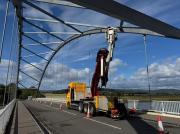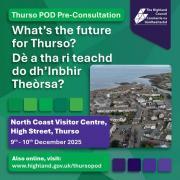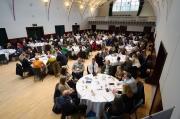Highland Council Launches Visitor Levy Consultation
16th August 2019
Highland Council today (15 August 2019) launched a consultation on a potential Highland Transient Visitor Levy.
The Council has not yet made a decision on whether to implement a Transient Visitor Levy (TVL), also known as a Tourist Tax. In December 2018 it committed to consulting Highland residents, businesses and visitors on a potential scheme.
The Consultation, launched at today's Environment, Development and Infrastructure (EDI) Committee, has been informed by detailed research into other regions' and countries' Visitor Levy schemes and the Council's Pre-Consultation meetings with tourism industry stakeholders across Highland.
Running until Autumn 2019, the main Consultation consists of two components: an online questionnaire aimed at residents and tourism businesses, but also open to visitors; and targeted face-to-face questionnaires with visitors at locations across Highland, conducted by the Moffat Centre for Travel and Tourism at Glasgow Caledonian University.
The Council has also produced a short video explaining the Council’s position and the Consultation.
Highland welcomes approximately four million overnight visitors a year, and another two million day visitors, including cruise visitors.
The Council’s rationale for considering a Visitor Levy is that visitors should help contribute to the maintenance and development of the free public services and infrastructure they use. In the context of the Council’s unprecedented budget pressures, revenue from a Levy could be used strategically to manage the impact of tourism and help the Council invest to ensure the region continues to be a great place to live and visit.
Depending on how a scheme was designed, a visitor Levy could generate between £5 and £10 million each year to invest in Highland tourism.
EDI Committee Chair, Councillor Allan Henderson, explained: "Highland welcomes visitors numbering roughly 25 times our resident population every year. Whilst visitors are very welcome, some of Highland’s infrastructure and services are struggling under the pressure of these additional users.
"Ultimately, the Council, with the help of everyone who responds to the Consultation, needs to decide what is better for our region: introducing a Visitor Levy, with its potential positive and negative impacts? - Or not implementing a Visitor Levy, avoiding potential negative impacts but limiting possible investment and therefore leaving the region with the problems we currently face."
Council Leader, Councillor Margaret Davidson, said: "Tourism is of huge importance to the Highlands. We recognise the benefits, challenges and impact that tourists have across the area and are committed to supporting this industry to ensure its success is sustainable.
"A Highland Transient Visitor Levy is one option the Council is considering to raise income to manage the challenges tourism is both facing and contributing to in Highland.
“The Consultation has been shaped by lots of research and engagement with the public and tourism industry to ensure we are asking the right questions. It does not simply gather information on people’s support or opposition. It gives respondents lots of opportunity to help us shape what a Levy might look like were it to be implemented. This includes important questions such as who should pay? How much? And how? And how revenue from a Visitor Levy could be invested to deliver maximum benefit for Highland?"
The Scottish Government has committed to introducing legislation by 2021 that would allow local authorities in Scotland to implement a Transient Visitor Levy. The Highland Council will use information gathered through its Consultation to ensure Highland is represented in the Government’s National Consultation.
Findings from the Visitor Survey, Open Consultation and research will be reported to Full Council on 12 December 2019.
Find the Survey HERE
Related Businesses
Related Articles
Exciting Career Opportunities With The Highland Council Now Open For Applications
# 10 December 2025 Career opportunities with The Highland Council The Highland Council is looking to fill a variety of posts relating to civil engineering and flood risk management based in locations across the area. Included are opportunities specifically for civil engineering graduates and technicians, providing the ideal job with career progression for anyone recently qualified and ready for a varied and interesting role.
What the NC500 Research Projects Are Designed to Do - and Why They Matter for the Highlands
As the North Coast 500 approaches its tenth anniversary, it has become one of Scotland's most well-known tourism success stories. The 516-mile loop around the far north of the Highlands has been celebrated internationally, marketed as a world-class road trip, and credited with transforming visitor numbers in some of Scotland’s most remote areas.Help Shape the Future of Thurso
The Highland Council is inviting people that live, work, or study in Thurso, to come along to the public consultation events to have their say. This is an opportunity to help shape the future of Thurso, to gather views and ideas.
Are Scottish Councils Quietly Reversing Outsourcing? A Look at Insourcing, Cuts and the Highland IT Shift
A notable article in the Guardian on 6 December 2025 noted the high sums being paid by London councils outsourcing services to private firms. The article starts with the reduction in council funding by UK government since 2010.Council welcomes Visitor Levy flexibility plan
The Highland Council welcomes moves by the Scottish Government to introduce greater flexibility on how it could design a Visitor Levy Scheme for consultation. The Visitor Levy (Scotland) Act 2024 currently provides local authorities with discretionary powers to implement percentage-based levies following statutory consultation.Highland Council is reaching out for views to shape its next 26/27 budget.
As it looks to set out its forthcoming priorities, the council is seeking involvement from members of the public, including businesses, community groups, parents, and young people. All their opinions are going to be crucial in deciding how Highland Council will take on its budget challenge for 2026-2027.Have your say in Thurso's future £100million investment by attending public consultation events
Thurso is to benefit from £100m investment in education and community facilities and are rolling out the first phase of public consultations on 9 and 10 December 2025. The Highland Council is inviting people that live, work, or study in Thurso, to come along to the public consultation events to have their say; this is an opportunity to help shape the future of Thurso, to gather views and ideas.Finding new owners for empty homes - Scheme launched to help return more empty homes to active use
A new online portal has been launched to bring empty homeowners together with prospective buyers or developers with the aim of facilitating more properties to be used as homes again. Covering the whole of Scotland, this builds on the success of local pilots, referred to as "matchmaker schemes".Consideration for short term let control area in Skye and Raasay
Steps towards introducing a short term let control area have been considered by Highland Council's Isle of Skye and Raasay area committee. On Monday (1 December 2025) the committee heard evidence to justify the grounds for the introduction of a Short Term Let Control Area covering all or part of Skye and Raasay.Workforce North event spotlights Highland economy
EMPLOYERS and educators from across the Highlands have gathered to hear how a new initiative is aiming to transform the region's economy. Workforce North - A Call to Action brought together business leaders and teachers from primary and secondary schools from across the Highland Council area with a wide range of partners geared towards education, learning and skills development at Strathpeffer Pavillion.
